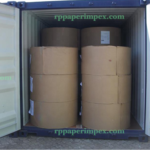GSM Paper Guide – What is GSM? What Does It Mean And How Do You Choose?
GSM Paper Guide – What is GSM? What Does It Mean And How Do You Choose?
GSM Paper Guide – What is GSM? What Does It Mean And How Do You Choose?- Selecting the right GSM Paper(Gram Per Square Meter) is important to achieve the desired result for your graphic design and printing procedure. The GSM Paper you choose can effectively impact the outcome of your project. comprehension the GSM helps you to make informed decisions.
The world of paper offers a vast range of options, by considering the kind of project, desired print quality, durability, and other factors, you can choose the appropriate GSM that meets your specific requirements and budget. Here is a detailed GSM Paper Guide to Understanding What is GSM. What does it mean and how do you choose?

What is GSM?
GSM measures the weight of the paper as grams per Square Meter. It is a standard unit used to quantify the thickness and weight of the paper. The heavier the number of paper means more grams per square meter and usually the higher the preserved quality of the stock. Mostly is referred to as the “grammage”.
To cite an example 150 GSM ( Flyer is Easy to fold and bend), 250 GSM (Flyer is a lot thicker and more effort needs to fold). To determine the correct measurement a square meter of the GSM paper is cut to size and weighed. Even when cut to a specific size, like A5 for a flyer, the GSM remains the same because it is measured based on the weight per square meter, not the size of the cut sheet.
GSM Paper Guide
The Thickness of paper measured in GSM matters for different products. Each item has its own ideal GSM based on its purpose. To cite an example for printing magazines you need 70-90 gr/m2. Another example of event promotions you need Leaflets and posters (130-170 gr/m2). Here is the complete Tabel with GSM paper guide For Your Printed Products:
| Tissue paper (18-50 gr/m2) | Thin Paper, easy for the media to glide across. |
| Newspaper (30-55 gr/m2) | Lightest paper ranging from translucent tracing paper to newsprint |
| Magazine paper (70-90 gr/m2) | Printing magazines, catalogs, brochures, and other similar publications. |
| Label paper (80-130 gr/m2) | Product labels, address labels, barcode labels, shipping labels, and office labels |
| Leaflets and posters (130-170 gr/m2) | Event promotions, retail flyers, many inserts, informational handouts, etc. |
| Brochure (170-250 gr/m2) | Informational booklets, DIY projects, event programs, retail promotions, etc. |
| Business Cards (250-400 gr/m2) | Professional appearance, long-lasting, custom design elements, photographs, and artists. |
| Small format paper converting (300-400 gr/m2) | Thicker cards are used as business cards, high-quality greeting cards, postcards, and brochure covers |
| Medium format paper converting (400-600 gr/m2) | Custom prints and posters, tags and labels, art prints and posters, marketing collateral, etc. |
| Premium business cards (400-600 gr/m2) | Luxury brand and services, professional image, executive level, special occasions, etc. |
| Large Format (+ 800 gr/m2) | Fine art printing, custom packaging, posters and signage, photographic packaging, etc |
What Does It Mean and How Do You Choose GSM Paper?
When you are choosing GSM paper multifarious factors impact your choices such as brightness, opacity, and color. Below we mentioned some crucial factors when you are choosing GSM paper for your project.
Consider the kind of material
- Leight Weight Less than 100 GSM: Ideal for newsletters leaflets and cost-effective promotional material.
- Medium Weight 100-200 GSM: suitable for business cards, higher quality promotional materials, and brochures.
- Highweight 200+ GSM: Provide premium feel right for items like high-end postcards, brochures, and invitations.
Quality of Prints
Generally higher GSM provides the best quality print that can hold and absorb more. If you require vibrant colors and sharp images select higher GSM paper.
Printer Compatibility
Project Types
Consider the nature of the product. To cite an example if you are printing photos you want higher GSM glossy paper for best quality image reproduction.
Durability
Durability is crucial like for invitations or business cards. Choose a higher GSM paper. Mostly thicker paper is less likely to tear.
Print Compatibility
Make sure that the selected GSM is compatible with your printer. Some printers have limitations on the thickness and weight of the paper they can handle.
Paper Texture and finishing
Different types of GSM come with several finishers and textures that include matte, glossy, or textured. Consider the best aesthetics you want for your project.
Budget Consideration
Often higher GSM papers are expensive. Look at your budget when making a choice. Make a balance between cost and quality you need in your project.
Eco-friendly options
Some Papers are made from recycled materials or sustainable resources. If the environmental process is a concern, check the paper specifications for eco-friendly options.
Testing
If possible test a small sample of the paper before making a large purchase. This supports you in evaluating the performance of your printer and the overall look and feel of the paper.
Colour and Opacity
Heavy weighted or higher GSM papers tend to have greater opacity, to eloborate, they are less transparent. This can be crucial, especially for double-sided printing, preventing text or images from showing through.



